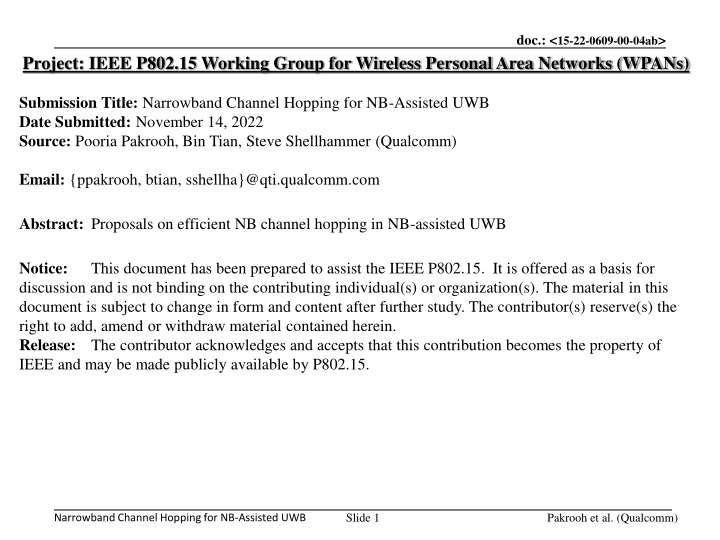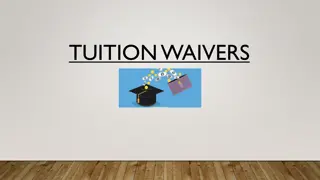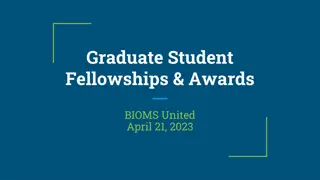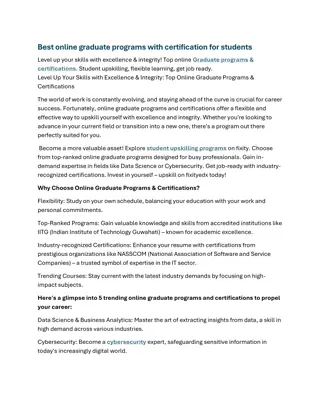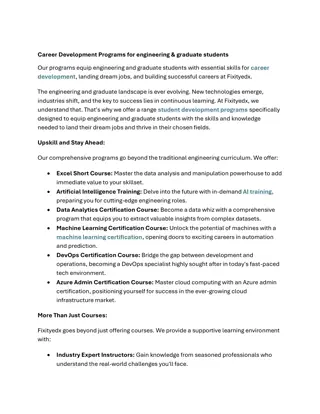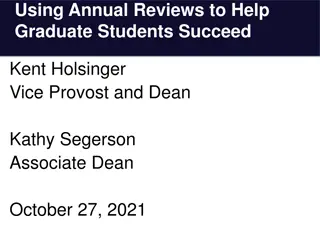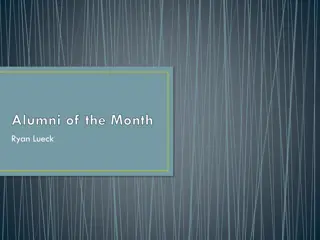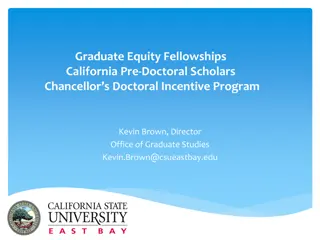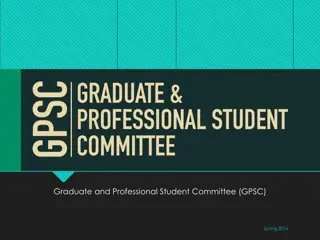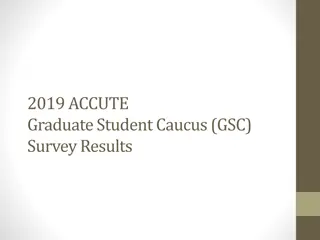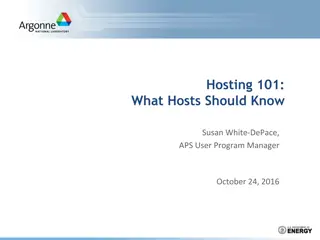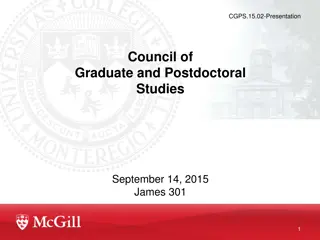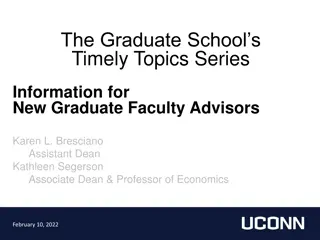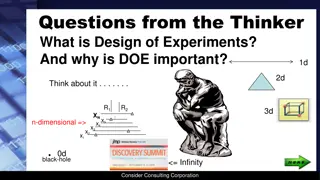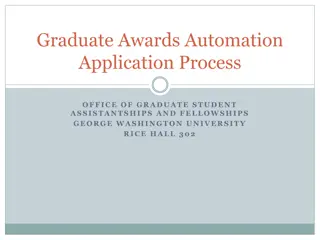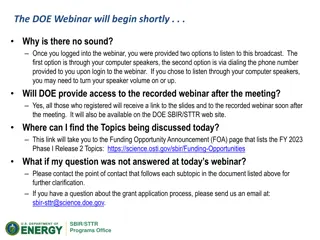DOE SCGSR Program for Graduate Student Research
The DOE Office of Science Graduate Student Research (SCGSR) Program offers awards to exceptional graduate students to conduct part of their doctoral thesis research at a DOE national laboratory. Applicants must align their research with specific priority areas and work with a DOE laboratory scientist. Check the eligibility criteria, benefits, key dates, and application process at the provided link.
Download Presentation

Please find below an Image/Link to download the presentation.
The content on the website is provided AS IS for your information and personal use only. It may not be sold, licensed, or shared on other websites without obtaining consent from the author.If you encounter any issues during the download, it is possible that the publisher has removed the file from their server.
You are allowed to download the files provided on this website for personal or commercial use, subject to the condition that they are used lawfully. All files are the property of their respective owners.
The content on the website is provided AS IS for your information and personal use only. It may not be sold, licensed, or shared on other websites without obtaining consent from the author.
E N D
Presentation Transcript
doc.: <15-22-0609-00-04ab> Project: IEEE P802.15 Working Group for Wireless Personal Area Networks (WPANs) Submission Title: Narrowband Channel Hopping for NB-Assisted UWB Date Submitted: November 14, 2022 Source: Pooria Pakrooh, Bin Tian, Steve Shellhammer (Qualcomm) Email: {ppakrooh, btian, sshellha}@qti.qualcomm.com Abstract: Proposals on efficient NB channel hopping in NB-assisted UWB Notice: discussion and is not binding on the contributing individual(s) or organization(s). The material in this document is subject to change in form and content after further study. The contributor(s) reserve(s) the right to add, amend or withdraw material contained herein. Release: The contributor acknowledges and accepts that this contribution becomes the property of IEEE and may be made publicly available by P802.15. This document has been prepared to assist the IEEE P802.15. It is offered as a basis for Slide 1 Pakrooh et al. (Qualcomm) Narrowband Channel Hopping for NB-Assisted UWB
doc.: <15-22-0609-00-04ab> PAR Objective Safeguards so that the high throughput data use cases will not cause significant disruption to low duty-cycle ranging use cases Interference mitigation techniques to support higher density and higher traffic use cases Other coexistence improvement Backward compatibility with enhanced ranging capable devices (ERDEVs) Improved link budget and/or reduced air-time Additional channels and operating frequencies Improvements to accuracy / precision / reliability and interoperability for high-integrity ranging Reduced complexity and power consumption Hybrid operation with narrowband signaling to assist UWB Proposed Solution (how addressed) Proposals on efficient NB channel hopping in NB- assisted UWB Enhanced native discovery and connection setup mechanisms Sensing capabilities to support presence detection and environment mapping Low-power low-latency streaming Higher data-rate streaming allowing at least 50 Mbit/s of throughput Support for peer-to-peer, peer-to-multi-peer, and station-to- infrastructure protocols Infrastructure synchronization mechanisms Slide 2 Pakrooh et al. (Qualcomm) Narrowband Channel Hopping for NB-Assisted UWB
doc.: <15-22-0609-00-04ab> Overview of NBA-UWB NB-assisted UWB has been proposed in 15.4ab as a method to improve UWB link budget. It consists of three phases: o Phase I: Initial synchronization Setting up and provide initial timing and frequency synchronization for phase II Open interface to support different technologies, e.g., BLE, UWB SHR, 15.4 O-QPSK PHY o Phase II: UWB Measurement Multiple 1ms segments to allow combining for link budget gain o Phase III: Measurement report Use the same technology as phase 1 NB proposal mainly targets O-QPSK (Zigbee PHY, clause 12 in 15.4) with potential improvements, in UNII-3 and UNII-5 bands o 250 channels introduced across UNII-3 and UNII-5 bands, with frequency hopping. In this presentation, we share high level suggestions on NB channel hopping o Priority channel lists in UNII-3 and UNII-5 bands to avoid interference with Wi-Fi o Defining channel hopping distance for diversity and avoiding interference with Wi-Fi Slide 3 Pakrooh et al. (Qualcomm) Narrowband Channel Hopping for NB-Assisted UWB
doc.: <15-22-0609-00-04ab> NB Channel Hopping Proposals Proposals for NB channel hopping sequence generation o Channel switching sequence via AES-128 PRNG, with pre-shared key/nonce among RAN participants [1] AES based switching achieves white noise a-like frequency diversity over set of allowed channels AES output can be deterministically biased to optimize coexistence o Use LFSR to generate pseudo random channel index, check with block list [2] Channel index in [0, M-1] log2M binary No Convert to decimal number and mod M in block list? Channel index Initial seed LFSR Yes Slide 4 Pakrooh et al. (Qualcomm) Narrowband Channel Hopping for NB-Assisted UWB
doc.: <15-22-0609-00-04ab> NB Hopping Rules and Cadence We recommend to do NB channel hopping only when there is NB transmission failure or when NB channel is busy o Efficient in spectrum usage, as it does not enforce unnecessary hopping What if NB transmission from one direction succeeds and the other direction fails? o If both NB message transmissions succeed (initiator responder and initiator responder ), no NB channel hopping is done. o If the first NB message and/or the second NB message do not go through, then UWB fragments are not transmitted. If the failure happens in initialization phase (phase I), then NB channel hopping is done in the next round, and NB message is retransmitted from initiator to responder. This process is repeated until initiator receives an ACK NB message from the responder. If the failure happens in measurement report phase (phase III), then NB channel hopping is done in the next round and the measurement report is included in the initialization phase of the next round. Slide 5 Pakrooh et al. (Qualcomm) Narrowband Channel Hopping for NB-Assisted UWB
doc.: <15-22-0609-00-04ab> NB Hopping Channel List To reduce interference, priority NB channel lists can be defined in UNII-3 and UNII-5 for NBA-UWB [3]. NB channel selection starts from priority channel list. Start by selecting a random channel from the priority list. o Example of priority channel list for UNII-3 band: 5730-5735MHz: 5MHz 5725-5730MHz (part of Ch#144): 5MHz o Example of priority channels for UNII-5 band can be defined based on regulatory rules. We are considering 5925-5945MHz. However, it is not still allowed in EU, and the regulatory rules in US are not clearly specified yet. Will be tracking the regulatory aspect. Slide 6 Pakrooh et al. (Qualcomm) Narrowband Channel Hopping for NB-Assisted UWB
doc.: <15-22-0609-00-04ab> NB Hopping Rule Proposing the steps below for channel hopping using prioritized channel list: 1. Start with a random channel in priority channels list 2. If NB transmission succeeds, same channel can be used for next NB transmission. 3. If it fails, hop to another random channel from non-priority channels list If there is failure in the selected channel, do channel hopping within the non- priority channels list Move back to the priority channel list if condition 1 or condition 2 is met o 1. Failure in non-priority channel is observed and a ?1 time duration has elapsed. o 2. A ?2 time duration has elapsed where ?2> ?1need to be decided. Slide 7 Pakrooh et al. (Qualcomm) Narrowband Channel Hopping for NB-Assisted UWB
doc.: <15-22-0609-00-04ab> NB Hopping Distance Using pseudo-random number generator (AES or LFSR) to directly generate channel number is not efficient in getting diversity or avoiding Wi- Fi interference. To avoid interference, and obtain NB channel diversity, it is more efficient to impose a minimum hopping distance between candidate channels. This minimum distance can be decided based on: o Achieving diversity, e.g., greater than 5MHz spacing. o Avoiding interference with Wi-Fi. If failure happens due to interference with Wi-Fi, it is likely that nearby channels also fail. Ensure hopping distance of 20MHz (minimum Wi- Fi BW). A proper hopping approach is to generate the hopping distance. o ????? + 1 = ????? + ? ? o Here, hopping distance ? ? = ?(?) + ???? ?. (where ? is total number of channels in the non-priority list) o ? is a fixed gap (in terms of channel number) to ensure min hopping distance. o ?(?) is the output of a PRNG such as LFSR or AES-128 methods. o Minimum hopping distance can ensure hopping outside of Wi-Fi channel bandwidth and avoid interference with Wi-Fi. Slide 8 Pakrooh et al. (Qualcomm) Narrowband Channel Hopping for NB-Assisted UWB
doc.: <15-22-0609-00-04ab> Summary In this presentation, we proposed to incorporate priority channel lists in NB channel hopping within UNII-3 and UNII-5 bands. This helps to reduce interference with Wi-Fi. NB channel hopping rules can be defined to exploit the priority channels and reduce the interference. For NB channel hopping, the hopping channel distance can be randomly generated, with a minimum distance between channels. This ensures hopping outside of a Wi-Fi channel bandwidth and avoids interference with Wi-Fi. Pakrooh et al. (Qualcomm) Narrowband Channel Hopping for NB-Assisted UWB
doc.: <15-22-0609-00-04ab> References [1] Narrowband Channel Access and Interference Mitigation for NBA- MMS-UWB, IEEE doc. 15-22-0340-01-04ab [2] NB considerations for NBA-MMS UWB, IEEE doc. 15-22-0420-00- 04ab [3] Discussion on NB-Assisted UWB, IEEE doc. 15-22-0156-00-04ab Slide 10 Pakrooh et al. (Qualcomm) Narrowband Channel Hopping for NB-Assisted UWB
